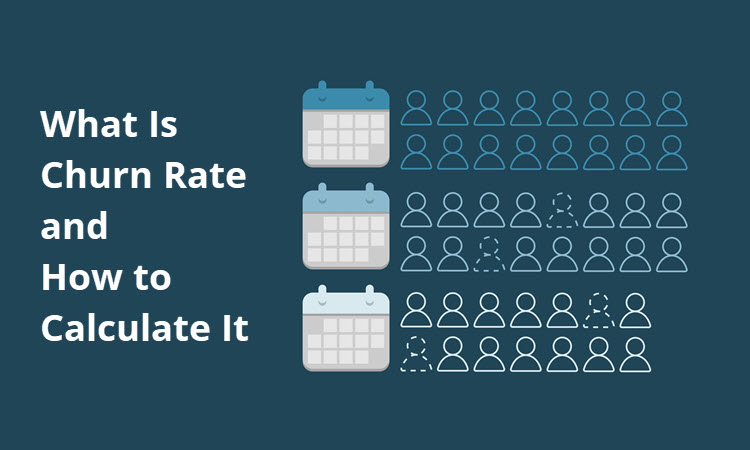Every subscription business’s success depends on the customer acquisition and retention rate.
These figures show how many users a business has at every single moment. They help subscription business owners calculate their profits and forecast recurring revenue.
The churn rate is another valuable piece of information because it shows how many customers have left a business within a specified period.
In this article, we’ll discuss churn rate in detail and explain how to calculate it.
What Is Churn Rate?

Churn rate is the percentage of customers that have stopped using a subscription service within a certain period. This metric includes subscribers that cancel or don’t renew subscriptions.
When a merchant knows their customer churn rate, they can calculate the customer lifetime value (CLV). The CLV is the total amount a customer has paid to a business in subscriptions.
A high churn rate means that many customers have left a business. It’s a sign that something needs to be changed.
A low churn rate is good. It means that a business meets most of its customers’ demands.
Churn Rate vs. Renewal Rate
Companies that want to monitor revenue consistently need to know their churn rate and renewal rate at every single moment.
While churn rate indicates how many customers have stopped using subscription services, renewal rate shows the number of subscribers that have renewed their subscription after the subscription period has expired.
Both rates are essential for calculating expected long-term revenue.
Note: CCBill is the leading provider of online payment services. Learn more about our Subscription Processing Services and what we can do for your subscription business.
How to Calculate Churn Rate?

The easiest way to calculate churn rate is to divide the number of churned customers by the total number of customers within the given period and multiply that number by 100:
(Churned Customers / Total Number of Customers) x 100 = Churn Rate
Let’s say that a business had 50 churned customers and a total of 1000 customers within one month. The formula goes as follows:
50 / 1000 x 100 = 5%
In this case, the customer churn rate for that month is 5%.
Merchants should calculate customer churn rate monthly or annually, but it’s possible to calculate churn rate for other periods, such as quarterly or semiannually.
Note: To understand changes in your churn rate, it’s important to compare churn rates from the same period – if you compare monthly churn with annual churn, you won’t get a reliable picture of changes in your churn rate.
Churn Rate Benchmarks and Statistics
Churn rates differ from niche to niche. Some industries are more dynamic, while others have more traditional patterns of customer acquisition and retention. As long as churn rates don’t exceed their expected thresholds, merchants don’t have to worry.
Merchants need to compare their own churn rates to the typical churn rates for their industry.
As reported by Statista, in 2020, telecom and wireless service providers had an average churn rate of 21%, while in the SaaS niche the churn rate averaged around 5%.
Causes of Customer Churn

Customers abandon subscription services for various reasons, including:
- Bad user and customer experience. Customers that can’t access all their paid features or don’t get proper customer support are more likely to churn. Merchants need to react promptly to customer complaints and improve customer service.
- Inadequate market placement. Merchants that don’t thoroughly research the market struggle with inadequate market placement of their services. Merchants must direct the right services at the right audience.
- High prices. If customers feel that the subscription value doesn’t support its price, they quickly churn. Merchants need to invest more time and money to convince customers that the services are worth their money. Value-based pricing is a valuable pricing model for reaching that goal.
Customer Churn Types
Churn rate can be voluntary and involuntary.
- Voluntary churn refers to the percentage of customers who intentionally stop paying subscriptions. They either don’t need the service in question anymore or become dissatisfied with the service.
- Involuntary churn happens when customers stop paying subscriptions due to external reasons. For example, their payment can’t be processed, they’ve moved to a location where they can’t access the services in question, or they’ve simply forgotten to pay the subscription.
Voluntary and involuntary churn can be further classified into five common types of churn:
- Failed onboarding. Most customers who cancel within the first month did not get a proper onboarding. They were not made fully aware of the values they get with the service, and decided that it’s not worth their money.
- Revenue churn. Revenue churn refers to the amount of revenue that a merchant loses during a specific period. Sometimes it happens because customers stop using a subscription service. But sometimes revenue churn happens when customers stay with the business but subscribe to cheaper pricing tiers, bringing lower revenue.
- Churn due to changed offers. When a business takes a different direction, it risks losing customers. Users that don’t get what they expect from products and services usually look for solutions in other places. Merchants that decide to introduce changes are usually aware of this fact. Still, they should monitor the churn rate to keep it within acceptable limits.
Note: Survey customers before making major changes to your product to feel the pulse of the market. Based on the results, decide whether the expected churn rate is acceptable or whether you should abandon the entire idea to prevent significant churn.
- Different values. Every company has some brand values. Some customers might not share those values but keeps using company services due to their quality or price. If the price goes up or packages change, they may eventually leave that business. Merchants can change their brand values to adapt to this segment, but then they risk losing other customers. It’s better to stick to core brand values and acquire repeat customers that share the same values.
- Interfering competitors. Customers change service providers in all industries, all the time. However, when you notice that customer churn rate is rapidly growing due to competitor interference, react at once. Analyze the periods when most of those churned customers left. Have you introduced any changes during that time without giving advance notice? Are there any new competitors that are offering better services at lower prices? Do the math and make decisions accordingly to reduce churn.
Survey customers to identify why they canceled their subscription. Follow-up emails are practical means of reaching out to customers that abandon a business. If you do it right, you can reacquire customers.
Conclusion
Churn rate is a reliable indicator of a business’s quality and success. Merchants need to use the average churn rate for their niche as a reference point and compare it to their own churn to see how well they’re doing.
The definitions, formulas, and tips shared in this guide ensure a better understanding of churn rate and how to use it for improved business results.
